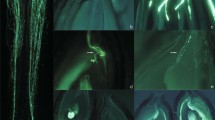Summary
In vitro pollen germination of cultivated tomato, Lycopersicon esculentum Mill., is inhibited by an ambient temperature of 5°C, more so than pollen from a Peruvian ecotype of Lycopersicon hirsutum Humb. & Bonpl. originating from an altitude of 3200 m. The frequency of L. hirsutum gametes contributing to hybrid zygote formation is more than doubled when controlled fertilizations with pollen mixtures of the two species occurs at 12/6°C as compared to crosses with the same mixtures at 24/19°C. The results suggest that differential selection at the gametophytic level occurs in response to low temperature regimes. To our knowledge this is the first time in higher plants that alteration of an environmental factor has been demonstrated to change selection values of male gametophytes in a fashion predicted by the ecology of the parental sporophytes.
Similar content being viewed by others
Literature
Charles, W.B.; Harris, R.E. (1972): Tomato fruit-set at high and low temperatures. Can. J. Plant Sci. 52, 497–506
Johnson, A.M. (1976): The climate of Peru, Bolivia, Ecuador. In: Climates of Central and South America. (ed.: Schwerdtfeger, W.) pp. 147–218 New York: Elsevier
Mulcahy, D.L. (1979): The rise of angiosperms: A genecological factor. Science 206, 20–23
Patterson, B.D.; Graham, D. (1977): Effect of chilling temperatures on the protoplasmic streaming of plants from different climates. J. Exp. Bot. 28, 736–743
Patterson, B.D.; Paull, R.; Smillie, R.M. (1978): Chilling resistance in Lycopersicon hirsutum Humb. & Bonpl., a wild tomato with a wide altitudinal distribution. Austr. J. Plant Physiol. 5, 609–617
Paull, R.E.; Patterson, B.D.; Graham, D. (1979): Amino acid uptake by tomato leaf tissue under chilling stress: Uptake conditions and a comparison of Lycopersicon species of different chilling resistance. Austr. J. Plant Physiol. 6, 475–484
Pfahler, P.L. (1967): In vitro germination and pollen tube growth of maize (Zea mays L.) pollen. I. Calcium and boron effects. Can. J. Bot. 45, 839–845
Rick, C.M.; Fobes, J.F.; Tanksley, S.D. (1979): Evolution of mating systems in Lycopersicon hirsutum as deduced from genetic variation in electrophoretic and morphological characters. Pl. Syst. Evol. 132, 279–298
Tanksley, S.D. (1979): Linkage, chromosomal association and expression of Adh-1 and Pgm-2 in tomato. Biochem. Genet. 17, 1159–1167
Author information
Authors and Affiliations
Additional information
Communicated by O.E. Nelson, Jr.
Rights and permissions
About this article
Cite this article
Zamir, D., Tanksley, S.D. & Jones, R.A. Low temperature effect on selective fertilization by pollen mixtures of wild and cultivated tomato species. Theoret. Appl. Genetics 59, 235–238 (1981). https://doi.org/10.1007/BF00265501
Received:
Accepted:
Issue Date:
DOI: https://doi.org/10.1007/BF00265501




